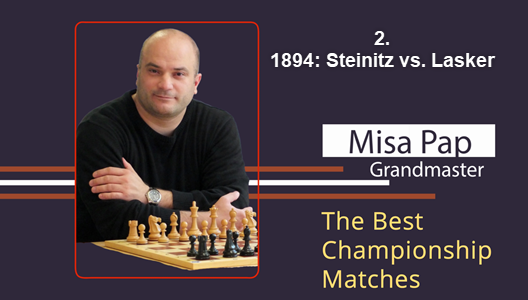Added on 3/11/2021

Video 2: The beginning of the Lasker era Emmanuel Lasker After Steinitz won his match against Zukertort, he continued to be successful. In that era, he was really the best player and the real World Champion! As we know, back in those times, matches for the world crown were still somewhat "privately" organized: namely, one of the world-leading players could challenge a champion for a match, and if he could raise enough money (enough purse or prize fund), usually the challenge would be accepted, and the match organized.
Such practice survived until 1948 when FIDE took over. But, let's not forget that FIDE was established only in 1924. in Paris, and back in 1894 and early 1900s, FIDE didn't even exist. Therefore, the world champion was in quite a good position, in that he could basically choose when and against whom he would defend his title.
Anyway, Steinitz didn't rest on his laurels, and he defended his title successfully 3 times.
In 1889, against the famous Russian GM Mihail Chigorin (let's note that the GM title did not exist officially back then; it would be formally introduced only in 1950). They played in Havana, and Steinitz won 10 - 6 with only 1 draw! In 1891, vs. Gunsberg in New York, Steinitz won 6-4 with 9 draws. In 1892, in Havana, again against Chigorin, it was very tough this time, and after 8-8 with 4 draws, only in tie-break did Steinitz win.
As you can see, results vary. At the time, the players agreed on different "contracts" almost for every match. Sometimes it was who won the first 10 games, sometimes who won the first 6. Anyway, these 3 matches were played under quite fair conditions: best of 20 games, and then tie-break if needed.
As we will see later, sometimes the Champion would retain his title if the match was tied.
In the 1890s, Tarrasch and Lasker emerged as the two best players (aside from champion Steinitz), and after Lasker challenged Tarasch to a match, getting a refusal(!), Lasker managed to raise enough money and challenge Steinitz for the title in 1894.
The match was played in the USA and Canada, in New York, Philadelphia, and Montreal. the first to win 10 games was to be declared Champion. Lasker, being 32 years younger, managed to win comfortably 10 - 5 with 4 draws.
Steinitz-Lasker - the match
Lasker also managed to win their return match in 1897, played in Moscow with the same format. This time Lasker won even more straightforward with 10-2, with 5 draws.
With this, the Lasker era began, and he managed to defend his title on several occasions, holding it for full 27 years, which is a record. Lasker was an efficient player, and some say he had a psychological approach to chess. He won several matches convincingly, defending his title against Marshall, Tarrasch, and Janowski. Only against Schlechter in 1910, Lasker had problems when he held the title with 1-1, with 8 draws!
Then came 1921. Lasker, much older than his opponent, lost to Capablanca, 0-4 with 10 draws. The match was played in Havana, and Lasker was already 52 years old, while Capablanca was only 32 years old.
